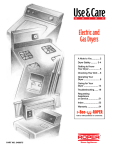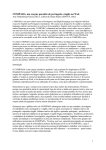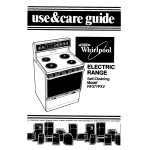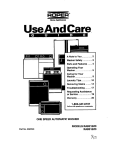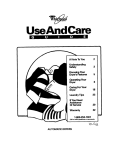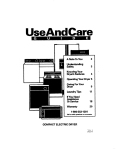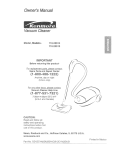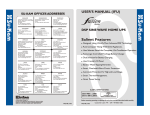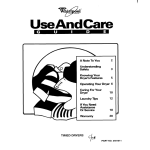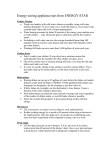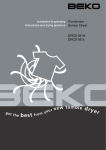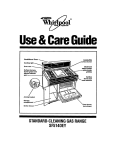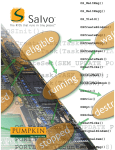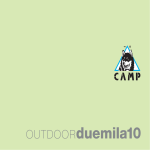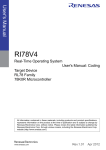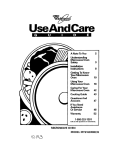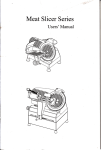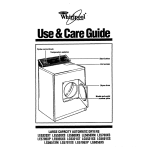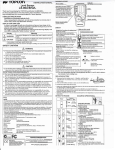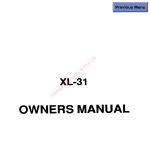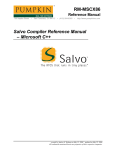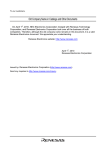Download Whirlpool REP3622B Specifications
Transcript
UseAndCare A Note To You 2 3 Knowin Your Dryed!smms 6 Operating Your Dryer 6 FOry- 10 Laundry Tips 12 EEg If Yqu Need @!a: Warranty 18 20 MOO4-ROPER cdlu8withqJodomwca#lmma COMPACT ELECTRIC AND GAS DRYERS MODELS REP3622B REC3622B RGC3622B A Note To You Thank you for buying a Rope@ appliance. You have purchased a quality, wo&claas home appliince. Years of engineering experience have gone into its manufacturing. Use thii Use and Care Guide to safely and efficiently operate and maintain your appliance. Complete and mail the Ownership Registration Card provided with your appliance. This will help us notify you about any new information on your appliance. Your safety is important to us. This guide contains safety symbols and statements. Pleass pay special attention to these symbols and follow any instructions given. Here is a brief explanation of the use of each symbol. This symbol will help alert you to such dangers as personal injury, bums, fire and electrical shock. Our toll-f rw number, is available 24 hours l-800-44-ROPER a day. This symbol will help you avoid actions whii could cause product damage (scratches, dents, etc.) and damage to your personal property. (l-800447-6737), If you have a question concerning your appliance’s operation, or if you need service, first see ‘If You Need Assistance Or Service” on page 18. If you need further help, call us. When calling, you will need to know your appliance’s complete model number and serial number. You can find this information on the model and serial number label (see diagram on page 5). For your convenience, we have included a handy place below for you to record these numbers, the purchase date from the sales slip and your dealer’s name and telephone number. Keep this book and the sales slip together in a safe place for future reference. Model Nuder Dealer Name Serial Nuder Dealer Phone Purchaaa ht. 2 Understanding Safety For your safety the information in this manual must be followed to minimize the risk of fire or explosion or to prevent property damage, personal InJury or -Do not store or use gasoline or other flammable vapors and liquids in the vicinity of this or any other appliance. -WHAT TO DO IF YOU SMELL GAS: l l l l l Do not try to light any appliance. Do not touch any electrical switch; do not use any phone in your building. Clear the room, building or area of ail occupants. immediately call your gas supplier from a neighbor’s phone. Follow the gas supplier’s instructions. if you cannot reach your gas supplier, call the fire department installation and service must be performed by a qualified installer, service agency or the gas supplier. 3 IMPORTANT SAFEnr INSTRUCTIONS To reduce the rtsk of fire, electricel shock., or injury to persons when using your dryer, follow basic precsutions, including the following: l l l l l l Read all instructions before using your dryer. Do not machine wash or machine dry items cleaned, washed, soaked in, or spotted with wax, paint, gasoline, oil, dry cleaning solvents, and other flammable fluids. The fumes can create a fire hazard or explosion. Always hand wash and line dry items containing these materials. Do not allow children to operate, play with or crawl inside your dryer. Supervise children when your dryer is used near children. Do not reach into a dryer if the drum is moving. When removing from service or discarding a dryer, always remove the door to prevent accidental entrapment. Do not dry mbber, rubber-like, and heat sensitive materiels with heat. Understanding your responsibilities Never operate the dryer if: -it is not working right (i.e. noisy, too hot). -it is dsmaged. -parts are missing. -all panels are not in place. -the lint screen is loose, damaged or missing. l Unplug the power supply cord or turn off electrical power before attempting to service your dryer. Shut off gas valve if you have a gas dryer. * Do not wash or dry items that are soiled with vegetable or cooking oil. These items may contain some oil after laundering. Due to the remaining oil, the fabric may smoke or wtch tire by itself. l Store flammable solvents or fluids away from your dryer. l Dry cleaning solvents or fluids should never be put directly into your dryer. l Install and/or store dryer where it will not be exposed to the weather. 0 Do not tamper with the controls. l You are responsible for making sure that your dryer is installed, repaired and has parts replaced by a qualified person. l Use only fabric softeners specifically labeled as not being harmful to the dryer. l Do not allow lint to buildup inside the dryer or exhaust system. Cleaning should be done perk&ally by a qualified person. l Clean lint screen before or after each load. l Do not let dust, lint, paper, rags, chemicals, etc. pile up around or under the dryer. l Dryer must be electrically grounded. See the Installation Instructions. l l Se sure that your dryer: -is properly installed and leveled on a floor that can support the weight in a well-ventilated room: -is connected to the proper outlet and electrical supply.* -is properfy connected to fuel and exhaust systems (gas dryers must be vented outdoors).* -is not installed against draperies or curtains, or on carpet.’ -is located in an area where the temperature is above 45°F (7%). -is property maintained. -is used only for jobs normally expected of home dothes dryers. -is not used by anyone unable to operate it properly. *See the Installation Instructions for complete information. - SAVE THESE INSTRUCTIONS 4 KnowingYour Dryer’s Features The parts and features of your dryer are illustrated below. Become familiar with all parts and features before using your dryer. NOTE: The drawings in this book may vary from your dryer model. They are designed to show the different features of all modele covered by this book. Your model may not include all features. othwhaluroz End of cyck dgnol b-w61 ‘&Atwn*-~ (240V modd Optional mounting kits You wn mount your compact dryer above your compact washer using one of the following: FlnurdEXPkrknhezard If mounting a gas dryer, use only Dryer Stand Kit, Part No. 695570. Using any other kit could result in a gas leak Failure to follow the above instructions could wuse fire or exolwion. l l only) Dryer Stand Kit for permanent installation, secured to the wall. Part No. 605570 (electric or gas) Stack Kii for free-standing installation. Part No. 346721 (electric only) Stack Kit to mount dryer permanently onto the washer. Almond Part No. 3300106 (electric only) White Part No. 3300175 (electric only) Dryer Wall-Mounting Kit for securing the dryer to the wall with a steel bracket. Part No. 345004 (electric only) l l NOTE: The wall must be strong enough to support the dryer’s weight. (Do not use in mobile homes.) Optional l deflector kit Exhaust Deflector Kit to move dryer exhaust up, down, or to the side. Part No. 346001 (electric only) 5 - Operating In This Your Dryer Section PW bfom startingyour &yr I- Stmding 01 mbpphg dryr you 1...1.... - . . ..-.... 6 End of cycb dgnd -..-..-.---...---6 6ofocthgocyclo,--“,-.“.,-“.““--,7 -s----.6 Operating your dryer properly assures the best drying results. This section gives you important information to help you to select a cycle, time, and temperature. Before starting your dryer NOTE: Remove any hang tags or temporary labels before using your dryer. Wipe dryer drum with a damp cloth to remove dust from storing and shipping. Refer to the information below, and “Laundry Tips” on page 12 for control setting, sorting, and loading information. Starting Starting or stopping your your dryer dryer Close the door and select a cycle. Push the Start Button. See pages 7-g for additional setting information. Your dryer automatically stops when a cyde ends. Stopping dryer and restarting your Open the dryer door or turn the Cycle Control Knob to OFF. Close the door; make new selection (if necessary). Push the Start Button. NOTE: The Cycle Control Knob should point to an OFF area when the dryer is not in use. If the dryer is stopped before the cycle is finished, turn the Cycle Control Knob to an OFF area. End of cycle signal The dryer sounds a signal to let you know when the cycle is finished. The signal is not adjustable and cannot be turned off. The signal is helpful when you are drying permanent press, synthetics, and other items that should be taken out as soon as the dryer stops. 6 Selecting a cycle Use pages 7 to 0 to find information about drying cycles that may be on your model. To Sebot I cycle: 1. Turn the Cycle Control Knob either way to a desired time or setting. 2. Stop when the indicator points to the cycle you want. 3. Push the Start Button. ChWghgaOOfOCth: 1. TumtheCydeControfKnobtopointtoa new setting. 2. Push the Start Button, if necessary. NOTES: l Use the Energy Preferred Automatic Setting (e) to dry most loads. See page 8. l The last few minutes of all cycles are without heat to make the load easier to handle. l To help reduce wrinkling, remove the load from the dryer as soon as tumbling stops. This is important for permanent press, knits, and synthetic fabrics. l Do not overdry. Overdrying can osuse shrinkage, static ding, and damage some fabrics. Flro Hazard Do not dry heat-sensitive fabrics, plastic, rubber, or some stuffed items with heat. Use the Air cycle or line dry. Failure to do so could result in fire or damaged Items. Using the Air cycle (no heat) The dryer does not heat when the Cycle Control Knob is set in the Air cycle. This cyde can be used to fluff or air dry bedding, plastic tablecloths, foam pillows, sneakers, etc. 1. Turn the Cycle Control Knob to the number of minutes you want in the Air cyde. (Cycle is unheated.) Refer to the chart on page 0 for suggested times. 2. Push the Start Button. NOTE: Repeat steps above if more time is needed to dry items. Using the Automatic PresJReg. cycle Perm. Use the Penn. Press/Peg. cycle to dry permanent press and some synthetic fabrfcs. Your dryer senses the dryness of the load and automatically shuts off when the selected dryness is reached. For the first few loads: 1. Set the Cycle Control Knob to point to the asterisk (*) in your Perm. Press/Peg. cY&. 2. Feel the dried items when the dryer stops. If the load is drier than you like, select LESS dry, or a setting closer to LESS dry, the next time you dry a similar load. If the load is not as dry as you like, complete drying using the Timed Drying cycle. Select MORE dry, or a setting closer to MORE dry, the next time you dry a similar load. The Cyde Control Knob will not move until the load is almost dfy or cool-down is reached. After cooldown is complete, the Cycle Control Knob automatically moves to an OFF area and tumbling stops. Using the Timed Drying cycle Use the Timed Drying cycle to complete drying if some items are damp after Penn. PressIFleg. cycle drying. Timed Drying is also useful to dry delicate items that require a short drying time, or large bulky items. 1. Turn the Cycle Control Knob to the number of minutes you want in the Timed Drying cycle. 2. For a damp dry, turn the Cycle Control Knob to 30 minutes or less. The last few minutes of this cycle are without heat to help make the load easier to handle. Selecting the right cycle and setting TYPE OF LOAD COlTONS AND UNENS Gtra Heavy-Bedspreads, mattress pads, quilts Heavyweight-Towels, jeans, corduroys, work clothes Mediumweight-Sheets, cotton underwear, diapers Lightweight-Satiates, organdies, lingerie PERMANENT PRESS, SYNTHETICS MD BLENDS Heavyweight-Work clothes, jackets, raincoats Mediumweight-Shirts, play clothes, sheets, slacks Lightweight-Lingerie, blouses, dresses KNITS Heavyweight-Cottons, rayons, blends, T-shirts, slacks, shirts Mediumweigh)-Synthetics (polyester, acrylic, etc.), dress slacks, skirts, sweaters Lightwelght+nthetics (polyester, acrylic, etc.) and blends, lingerie, blouses, dresses CYCLE Tmed D@ng Perm. PressIReg. MODELS REC3622B RGC3622B REP3622B 45-55 min 90-l 05 mir Penn. Press&g. Perm. Press/Reg. Perm. Pressmeg. Penn. Press/Reg. Perm. Press/Reg. Perm. Press/Reg. Perm. PressAGo. Perm. Press/Reg. D-ATE FABRICS Sheer cuttains (2 or 3 panels), gauze, lace, etc. Air 20-30 min 20-30 min RUBBER, PLASTIC, HEAT-SENSTTIVE FABRICS Foam Rubber-Pillows, bras, stuffed toys Plastk+Shower curtains, tablecloths Rubber-backed rugs Olefin, Polypropylene, Sheer nylon Air Air Air Air 20-30 20-30 40-50 15-20 20-30 20-30 40-50 15-20 min’ mine min’ min’ min’ min’ min’ min’ ‘Reset fir cycle as needed to complete drying. 0 Caring For Your Dryer In This MainSay Section Pm bmd ..--......- . . . . . . 10 Udntmnocu nom&d,-,--...---10 Dryers require regular maintenance. Follow the suggestions below to maintain your dryer properly. Maintenance-every Cleaning the lint load screen The lint screen is located inside the dryer drum, on the back wall. Clean tt before eacJ’t load A screen blocked by lint can increase drying time. 1. Open the door and pull the lint saeen straight out. 2. Squeeze body of lint screen lightly while pulling the cover off. See illustration. 3. Roll lint off the screen with your fingers. Do not rinse or wash the screen to remove lint. Wet lint is hard to remove. 4. Replace cover on lint screen body. Push the lint screen firmly back into place and close the door. Maintenance-as needed Use the following suggestions about cleaning and lint removal to maintain your dryer and keep it operating efficiently. Cleaning a clogged lint screen Laundry detergents and fabric softeners can cause a residue build-up on the lint saeen. A dogged lint screen can extend drying times. Clean the lint screen every six months or more frequently if it becomes dogged due to a residue buildup. Use the following method: 1. Wet both sides of lint screen with hot water. 2. Wet a nylon brush with hot water and liquid detergent. 3. Scrub lint screen with the brush until all residue build-up is removed. 4. Rinse with hot water. 5. Thoroughly dj lint screen with a clean towel and replace in dryer. 10 Do not run the dryer with the lint screen loose, damaged, blocked or missing. Doing so can cause overheating and damage to both the dryer and fabrii. Cleaning the dryer interior Garments which contain unstable dyes, such as denim blue jeans or brightly colored cotton items, may discolor the dryer interior. If you want to remove stains from dryer drum, use powdered laundry detergent. 1. Make a paste with detergent and very warm water. Apply paste to a soft cloth and 2. scrub area until all excess dye is lWTlOVed. Ekctrkal Shock, Pusonal h)uy, Fke, Md Exploalon Hazard l Turn off the electrical power before cleaning the interior. l Make sure the dryer is cool. l Use nonflammable cleaner. Failure to do so could result in electrical shock or injury, tire or explosion. 3. wipe thoroughly with a damp cloth. 4. Tumble a load of rags to dry. Cleaning the dryer exterior Wipe with a soft, damp cloth. Removing accumulated lint Lint can gather inside the dryer and be a fuel for fire. It is recommended that lint be removed every 2 to 3 years, or more often, depending on dryer usage. Cleaning should be done by a qualified person. If you have any questions, please call our toll-free number at l-800-447-6737. Elecbkal Shock and P-I InJury Hazard l Unplug the power supply cord, or turn off the electrical power at the main power supply before removing dryer panels. l Make sure the dryer is cool. l Dryer parts can have sharp edges. Use care when handling. Failure to do so could result in electricsl shock or personal injury. 1. Unplug the power supply cord, or turn off the electrfcal power at the main power supply. 2. Remove back panel (electric) or lower front access panel (gas). 3. Remove lint from shaded area in illustration with a soft brush or vacuum cleaner. Avoid damaging wires, thermostats (electric). funnel (gas) or ignitor (gas). 4. Replace panel; reconnect and level dryer again, if necessary. Electric dryer wlth back panel removed Gas dryer with bwar f rant eccew panel removed 11 Laundry Tips I In This Section you dry .. . . . . . . . . . . . . . . . . . . . . . . . . . . . . . . . . . . . . . . . . . . . . . .. . 12 Drying special-care Swing energy care . . . . . . . . . . . . . . . . . . . . . . . . . . . . . . . . . . . . . . . . . . . . . . . . . . 15 Vacation 13 Voltage requirements ......................... .15 Solving laundering itsms ................................ Using dryer fabric softeners.. Paw Pa* Before ................................................... .................................... problems ....................... 15 16 15 This section reviews proper drying techniques, gives you additional drying information, and discusses causes or solutions to common drying problems. Before you dry Before using your dryer, see pages 3 and 4 for Important Safety Information. Drying l l l l l l l Separate dark from light colors; colorfast from noncolorfast. Items properly tips Close zippers, snaps, and hooks to avoid snagging other items. Remove pins, buckles, and other hard objects to avoid scratching the dryer drum. Remove heatsensitive trim that can by drying. Check garments to make sure all spots and stains were removed during the wash. If stains were not removed, do not tumble dry. Heat may permanently set stain. Soiled items can also leave stains on the dryer drum. These stains can be picked up by other items in the load. tal objects can damage your dryer. Check pockets for pins, clips, money, bolts, nuts, etc., and turn pockets inside out. Do not lay these objects on your dryer after emptying pockets. Tie strings and sashes so they will not tangle. Turn lint takers and dark items inside out to help prevent lint pickup. Place small items such as baby socks or hankies in a mesh bag for easier removal. Articles to be ironed should be removed from the dryer while still damp. 12 Sorting l Separate lint givers (towels, chenille) from lint takers (corduroy, synthetics, permanent press). When possible, turn lint takers inside out. Load sizes *Mix large items with smaller items. Load the dryer by the amount of space items take up, not by their weight. Do not overload the dryer. Overcrowding causes uneven drying and wrinkling, and can cause items to wear out faster (because of pilling). l You may need to rearrange large items (sheets, blankets, tablecloths) during a cycle to reduce balling or rolling up. l Reduce wrinkling of permanent press and synthetics by drying smaller loads and removing items from the dryer as soon as tumbling stops. l For better tumbling action when drying only a few small items, add one or two lint-free towels. This also prevents small, lightweight items from blocking airflow. I Drying special-care items Most garments and household textiles have care labels with laundering instructions. Always follow label directions when they are available. General drying instructions for some special washables are included in this section. Heat-sensitive fabrics, plastic, rubber, or some stuffed items require drying without heat. Use Air cycle or line dry. See Warning on page 7. Heat-sensltlve fabrics l Cotton and canvasshoes If shoes can be machine laundered: 1. Place several bath towels in the dryer to act as a buffer. 2. If rubber or foam rubber materials are part of the shoe, use Air cycle. For other materials, see pages 7 and 9 for cycle, time or temperature recommendations. 3. Remove shoes from dryer while still damp and allow to air dry. Pillows, stuffed toys l Feather, foam, polyester If manufacturer recommends machine drying, dry one pillow at a time. Refer to Air cycle, pages 7 and 9. 1. Make sure coverings are securely stitched. 2. Shake and fluff the items by hand several times during the cycle. 3. Make sure pillows are completely dry. Feather pillows take a long time to dry. Blankets woolens Machine drying knitted woolens is not recommended. Block to shape when wet and allow to air dry. Line dry blankets in shade on a breezy day over two lines. Pin edges together and straighten them. When partly dry, turn the blanket over, repin and restraighten. When dry, brush nap. Dry as recommended for permanent press fabrics on page 9. If manufacturer recommends machine drying: 1. Place one or two dry towels in the dryer and preheat 3-5 minutes on a high setting. This will dry blankets faster and help avoid pilling. 2. Put blanket in dryer with warm towels. Set control for 20 minutes. 3. Check after 10 minutes. Remove when still damp. Overdrying and long tumbling can cause shrinking and pilling. 4. Place blanket on flat surface or over two lines to finish drying. Gently stretch to original size and shape. 5. When completely dry, brush gently to raise nap. Press binding with cool iron if needed. l l and Cotton, rayon, synthetic blankets Electric blankets, electric sheets, woolen blankets, washable woolen garments Curtains, sllpcovers l l l Remove drapery weights and hooks before laundering. For slipcovers, replace while still slightly damp. They will dry to fit tightly. Draperies, slipcovers Dry only a few minutes. 1. Leave room in dryer for load to fluff. 2. Remove from dryer while slightly damp. Do not overdry. Sheers, some synthetic curtains Bonded or laminated fabrics Dry only a few minutes. Line dry these items. . continued . on next page 13 Diapers, clothes Elastic baby items Wash and dry small items in a mesh bag or pillowcase for convenient handling. 1. Dry according to manufacturer’s instructions. 2. Remove diapers and cotton knit items while still slightly damp. They will feel softer, shrink less, and be easier to fold. Remove from dryer while still slightly damp. Flbergiass materials Do not machine wash or dry fiberglass materials. Small particles can stick to fabrics washed or dried in following loads and cause skin irritation. Fiameretardant finishes Some items have been treated with a flame-retardant finish to improve their resistance to burning. Such items are clearly labeled. To retain flame-retardant qualities through continuous use and washing, clean and dry according to the manufacturer’s instructions. Napped l Items Corduroy, velveteen Dry separately or with similar colors to avoid lint transfer. Follow care label directions. 1. Dry according to manufacturer’s instructions. 2. Remove from dryer while there is still a trace of moisture. 3. Smooth, reshape and air dry before putting away. Quilted, downfilled items Follow care label instructions. 1. Dry one at a time. 2. Remove from dryer and shake or fluff the item during the drying cycle. 3. Smooth and reshape before putting away. Snowsuits, Jackets Check label for fiber content, then follow care label directions. l Nylon, polyester-base Dry according to manufacturer’s instructions. 1. Dry garment for about 10 minutes. Remove and turn inside out. Dry for 10 more minutes. 2. Remove from dryer immediately and hang on a nonrusting hanger to finish drying. This will help eliminate wrinkles. Tinted, dyed or noncolorfast Items Dry according to fabric, weight and care label instructions. Wipe the dryer drum carefully to remove any dye or lint that can be transferred to other loads. See “Cleaning the dryer interior” on pages 10 and 11. Towels Select cycle according to fabric type. Some towels, particularly those made of a blend of synthetic fibers and natural fibers (polyester and cotton blends), may shed more lint than other towels causing your dryer’s lint screen to get full faster. Be sure to remove lint from the dryer lint screen before and after drying new towels. Washable knits Do not overdry knits. Overdrying can cause shrinking and static cling. 1. Select cycle according to fabric and construction. 2. Turn synthetics and blends inside out when drying to avoid pilling. 3. Remove cotton and rayon knits while still slightly damp. Stretch into shape and lay flat to finish drying. Using dryer fabric softeners Dryer fabric softeners are recommended for reducing static cling (static can also be reduced by not overdryiig) and for softening fabrics. Always follow package instructions carefully. l Put fabric softener sheet on top of the load beforestarUngtbedryu.Donotadda fabric softener sheet atter the cyde has started. Instant heat can cause the fabric softener to spot fabrics. Saving l l l l Clear, grease-like spots can result from the fabric softener sheet becoming tangled in an item during tumbling. If fabric softener causes a stain, wet the stain and rub with liquid detergent or bar soap, rewash. Some fabric softeners can clog the lint screen and slow drying. Use fabric softeners labeled as dryer safe. energy Dry only full loads without overdrying. Avoid overloading dryer, adding wet items to a partly dried load, or opening the door unnecessarily. Plan your laundry to dry one load after another. A warm dryer shortens drying tfme. Vacation l l Shorten d@ig times by exhausting dryer properly and cleaning exhaust duct as needed. -Keep the lint screen clean. - Use your dryer in a room where room air temperature is above 45°F (7°C). -Sort loads by fabric weight and type. care 1. Unplug power supply cord or turn off electrical power supply. 2. Clean lint screen. Voltage l l requirements Model REC3622B operates on 240 or 206 volt household current. Models REP3622B and RGC3622B operate on 120 volt household current. NOTE: Electric dryers using 206 or 120 volts require longer drying times than dryers using 240 volts. 15 Solving laundering problems Most laundering problems are easily solved. Check the following list for problems you may have and possible causes. If you need additional help, check the “Assistance or Service” section of this book PROBLEM G-Y w- 10 CHECK IF CAUSES/SOLUTIONS Dryer fabric softeners were used Follow manufacturer’s product directions carefully. Undiluted washer fabric softener was used Dilute fabric softener before adding to the final rinse. Enough detergent was used Use enough detergent to hold soil in the wash water until it drains away. Undrained soil can stick to outer tub of the washer and cause greasy spots with next load. Items were dean before they were dried Soiled items can stain other items in the load. They can also leave stains on the dryer drum that can be picked up by items in later loads. Dryer heat may permanently set these stains. Lint screen is full Clean lint screen. (Bee page 10.) Load is properly sorted Sort lintgivers (bath towels, etc.) from linttakers (synthetics, permanent press). Static electricity is attracting lint Use fabrii softener in the washer’s final rinse. Use correct dryer settings for fabric. Cverdrying synthetics can cause lintattracting static electricity. Load is too big or heavy Dry smaller loads. When items can’t tumble freely, air is unable to carry lint to lint screen. Paper or tissue was in pocket Empty pockets carefully. A small scrap of paper can cause a lot of lint. Enough detergent was used Use enough detergent to hold the lint in the water until it drains away. Bass detergent amount on water hardness and soil in wash load. Pilling is being mistaken for lint Pilling (surface fuzz) is caused by normal wear and laundering. Pills do not break away easily from the fabric and csn often collect lint. Synthetic fabrics are more likely to pill than others, especially at neckbands, elbows and knees. CHECK IF PROBLEM =*ldno slow drying CAUSES/SOLUTIONS Items are oven&fed Remove items while there is still a trace of moisture. Some itema should be removed while dsmp. then shaped and air dried. Fabric type and quality is suitable for dryiig Some knits are stretched during manufacturing. Washing and drying returns them to the original size. This is normal. Check quality of garment before buying. Follow fabric care label directions carefully. There is a large amount of moisture in the load to be dried Some items hold more moisture than others (cottons more than polyester). They take longer to dry. Full loads take longer to dry than small loads of the same fabric. Cold rinse water ia used A load rinsed in cold water will take slightly longer to dry than a warm one. Cold rinses, however, help save energy and reduce wrinkling more than warm rinses do. Room air tempemture is below 45°F (7%) Install dryer in a room where the air tempemture is warmer than 45°F (7%). Cold air increases drying time and may cause wrinkles not to be removed. Dryer is exhausted according to Installation lnstructlons Install and exhaust your dryer according to the Installation Instructions provided. Lint screen is full Clean lint screen before or after each use. Exhaust duct or outside exhaust hood is clogged Proper electriil supply is Clean if needed. Used Properly connect the dryer to a grounded electrical circuit that meets the electrical requirements stated in the Installation Instructions. Load is overdried Remove items while there is still a trace of moisture. Fabric softener is used Use a fabric softener and follow package directions carefully. Synthetics, synthetic blends, permanent press and knits are in load Synthetics, synthetic blends, permanent press and knits build up static electricity. Use a fabric softener and be careful not to overdry the load. 17 If You Need Assistance Or Service 1. Before calling for assistance ... Is the power cord plugged in? Is lint screen clogged with lint? q - Is exhaust duct or outside exhaust hood clogged with lint? •l!l - Have you blown a fuse or trfpped the circuit breaker? If you need more help, check the chart below. PROBLEM CHECK THE FOLLOWING Dryer will not run Is the power cord firmly plugged into a live circuit with proper voltage? Has a household fuse blown or circuit breaker tripped? Has a time-delay fuse been used? Is the dryer door firmly closed? Did you firmly push the Start Button? Are the controls set in an ON position? Dryer will not bent Is the cycle in the last few minutes7 (There is no heat during that time.) Has a household fuse blown or circuit breaker tripped? Has a time-delay fuse been used? If you have a gas dryer, are the valves open on both the dryer and the supply line? Drying time too kng 18 Is your lint screen clean? (See the ‘Slow dryin< section of the table on page 17 for additional information.) Is your exhaust duct or outside exhaust hood clogged with lint? 2. If you need assistance* ... Call WI toll-fro. numbu. Dial toll-fro. tram Mywher. In the U.S.A.: l-30044-ROPER (1400-447~737) and talk with one of our trained consultants. The consultant csn instruct you in how to obtain satisfactory operation from your appliance or, ff service is necessary, recommend a qualifti service company in your area. If you prefer, write to: Mr. William Clark Consumer Assistance Representative Roper Brand Appliances 2000 M-63 Benton Harbor, MI 49022 Please include a daytime phone number in your correspondence. 3. tf you need service* 4. If you need FSP ment parts . . . FSP is a registered trademark of Whirlpool Corporation for quality parts. Look for this symbol of quality whenever you need a replacement part for your Ropep appliance. FSP replacement parts will fit right and work right, because they are made to the same exacting specifications used to build every new Roper appliance. To locate FSP replacement parts in your area, refer to Step 3 above or call our toll-free telephone number in Step 2. 5. tf you are not satisfied how the problem was solved . . . l ... Contact the dealer from whom you purchased the appliance or the authorized servicer in your area. For help finding an authorized senricer in your area, call our toll-free telephone number in Step 2. ‘WhMWklltgtOrhdpOrSUVlW: Please provide a detailed description of the problem, your appliance’s complete model and serial numbers and the purchase date. (See page 2.) This information will help us respond properly to your request. replace- l l with Contact the Major Appliance Consumer Action Panel (MACAP). MACAP is a group of independent consumer experts that voices consumer views at the highest levels of the major appliance industry. Contact MACAP only when the dealer, authorized senricer and Roper Brand Appliance warrantor have failed to resolve your problem. Major Appliance Consumer Action Panel 20 North Wacker Driie Chicago, IL 60606 MACAP will in turn inform us of your action. 19 ROPER’ Dryer Warranty LENGTH OF WARRANTY: WHAT WE WILL PAY FOR: FULL ONE-Y EAR WARRANTY (from date of purchase) FSP replacement parts and repair labor to correct defects in materials or workmanship. Service must be provided by an authorized Roper service company. WHAT WE WILL NOT PAY FOR: A. Service cells to: 1. Correct the installation of your dryer. 2. Instruct you how to use your dryer. 3. Replace house fuses or correct house wiring or plumbing. 4. Replace owner accessible light bulbs. B. Repairs when your dryer is used in other than normal, single-family household use. C. Pickup and delivery. Your dryer is designed to be repaired in the home. D. Damage to your dryer caused by accident, misuse, fire, flood, acts of God, or use of products not approved by us. E. Repairs to parts or systems caused by unauthorized modifications made to the appliance. 842 This Roper appliance ia warranted by Whirlpool Corpomtion. Under no circumstances shall it be liable under this warranty for incidental or consequential damages and all implied warranties are limited to the same time period stated in the express warranties for Roper Brand Appliances. Some states do not allow the exclusion or limitation of incidental or consequential damages, so this limitation or exclusion may not apply to you. This warranty gives you specific legal rights, and you may also have other rights which vary from state to state. Outside the United States, a different warranty may also apply. For details, please contact your authorized Roper distributor or military exchange. If you need service, first see the “Assistance or Service” section of this book. After checking ‘Assistance or Service,” additional help can be found by calling our toll-free telephone number, 1400-44-ROPER (1400-4474737), from anywhere in the U.S.A. PART NO. 9830930 01--- PM h U.8A




















